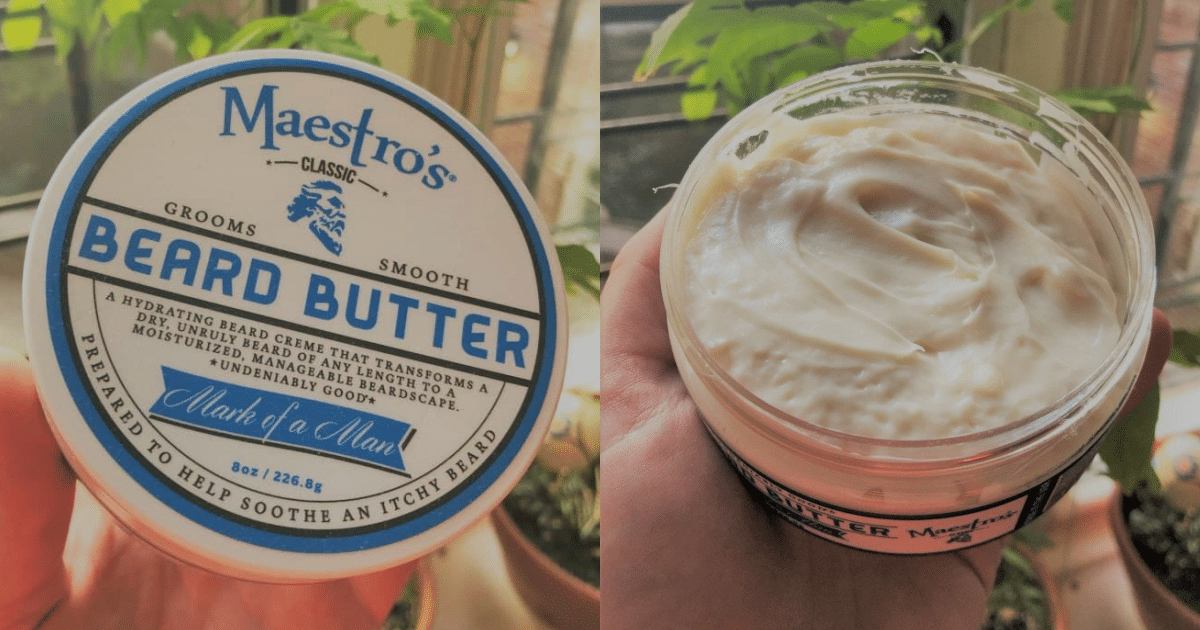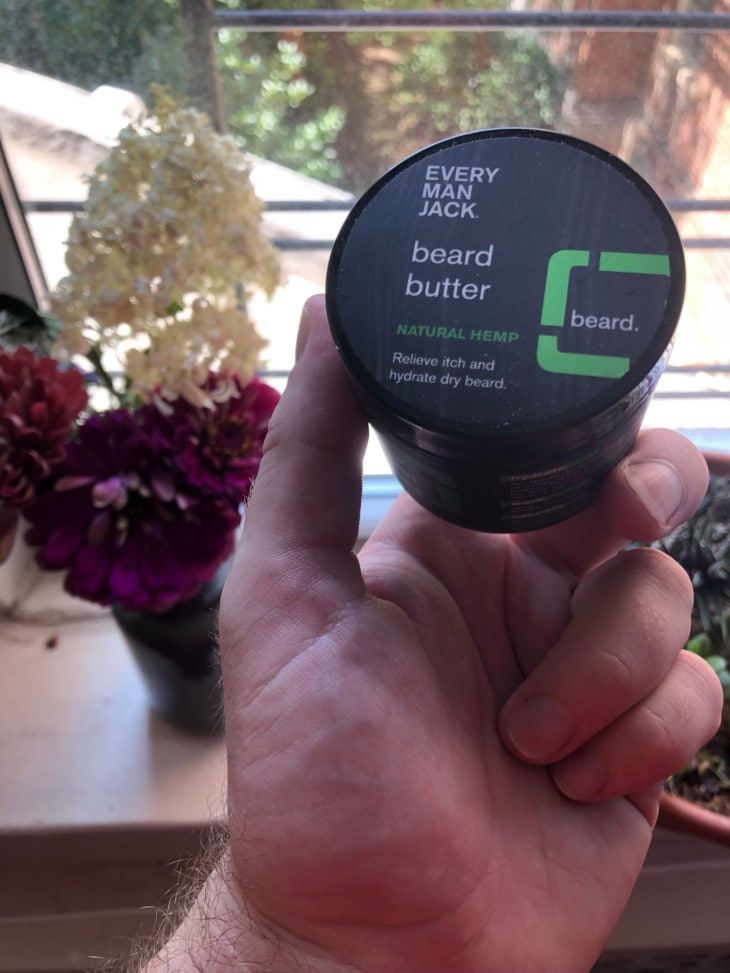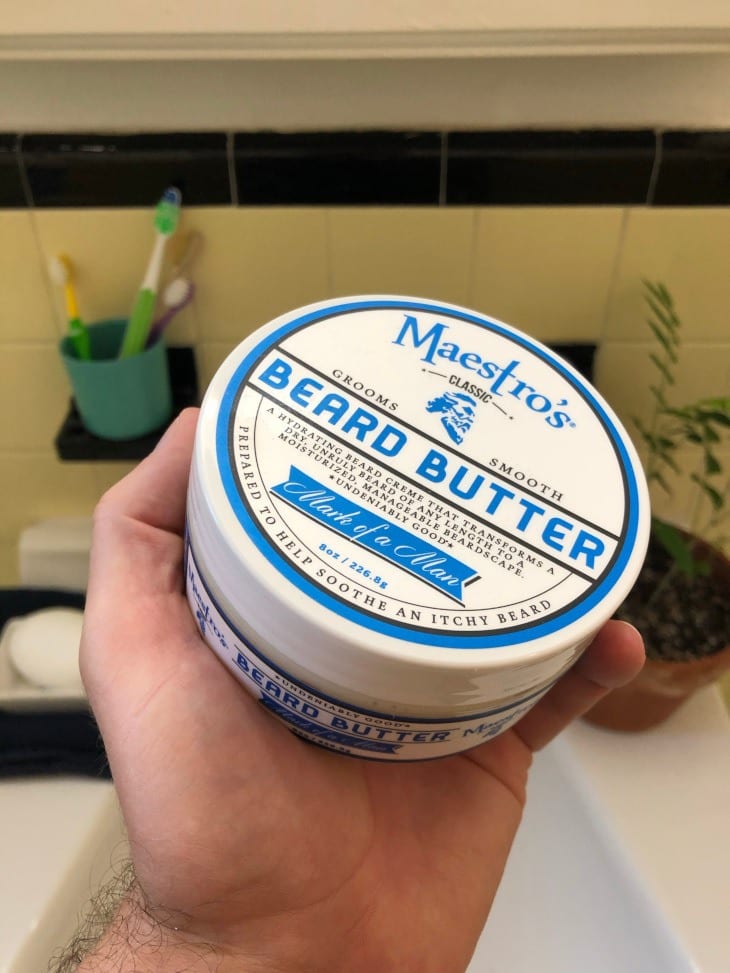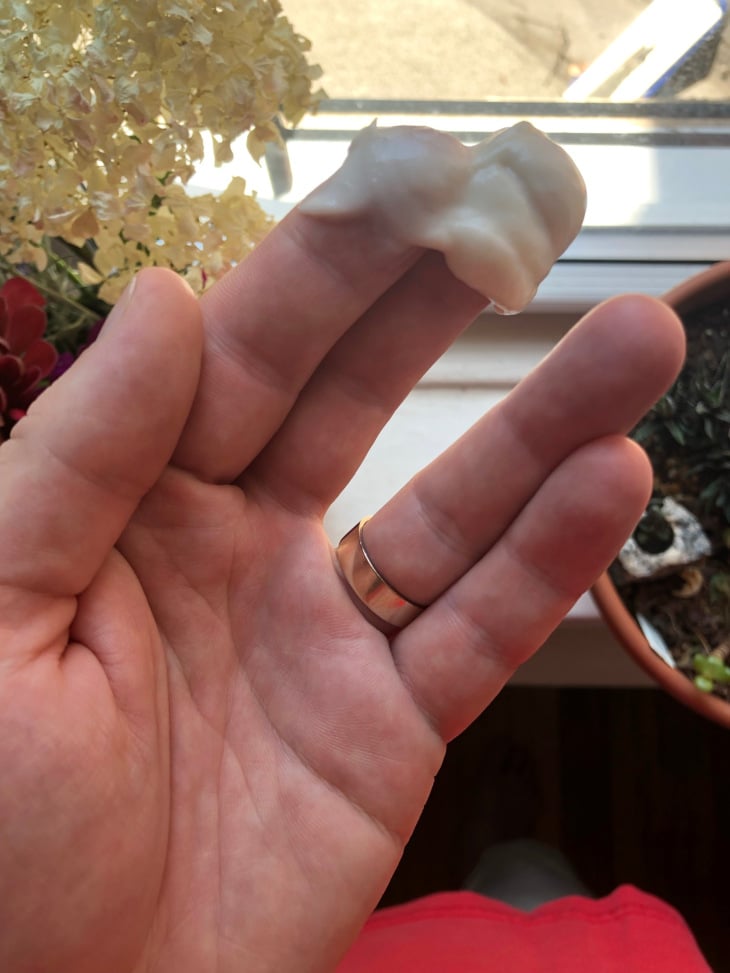When we started this website and decided we’d talk about beards and shaving, we didn’t realize how. many. posts. we’d have to write describing the differences between beard products. Beard products—which should be pretty simple to understand—are actually really confusing, because there are dozens of them, and their names never really seem to describe what they do. If you’re asking, “What is beard butter, anyway?” you’re not alone—guys who are new to having beards are almost always confused by the differences between beard oils, and beard balms, and beard butter vs beard oil.
Add to that beard wax, various shampoos and beard washes, and some attractively packaged creams, and it’s … a lot.
So here we’ll tell you just about everything you’ll need to know about how to choose and use the best beard butter.
It’s not the most popular product out there—that would be beard oils and beard balms—but it seems like many of the guys who use it absolutely love it (and that would include us).
So let’s start here:
What Butters for Beards Are Made of, and What They Do
What is a “butter,” anyway? When most of us hear the term, we think of table butter—the off-white/yellow spread you put on your bread. We get asked a lot of there’s actually butter in a beard butter, and no—there’s no butter in it. Not any table butter, anyway.
The term “butter” can generally describe anything that’s creamy and spreadable, and when it comes to grooming products, “butters” usually refer to shea butters, cocoa butters, and mango butters. When you extract the fat from these plants—that is, when you extract the fat from the nut of the African shea tree, or the fat from a cocoa bean, or the seed oil from the stone of a mango—and then you process it, you can create a creamy, velvet-y lotion that you can spread on the skin.
Here’s a picture of a beard balm—Maestro’s—in the tub:
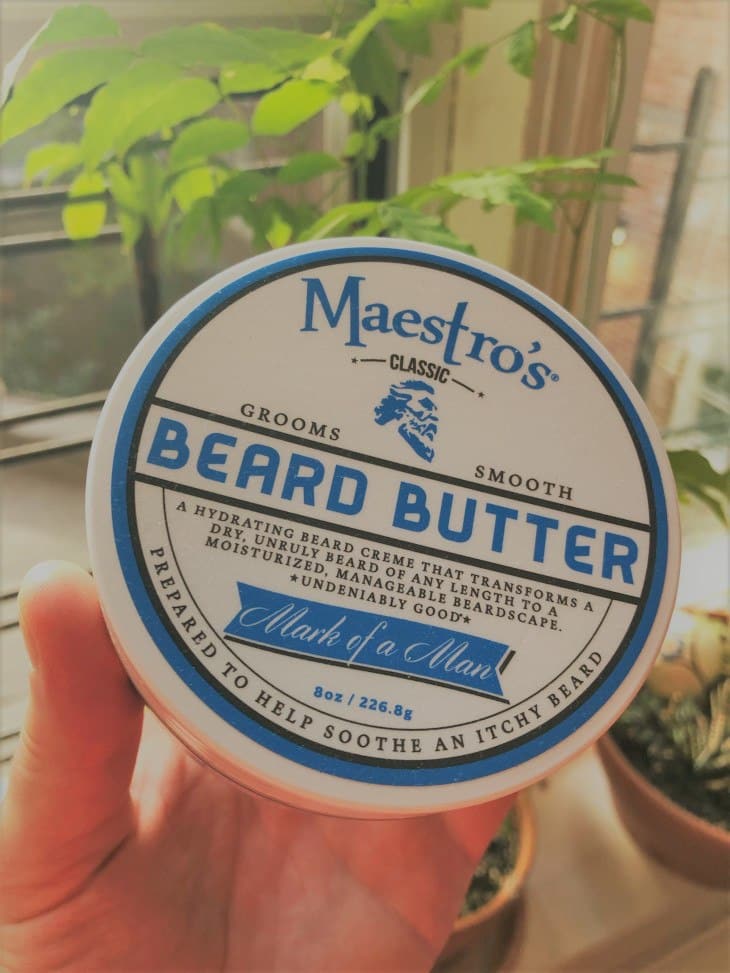
Beard butters tend to come in deep tubs like that (although the Maestro’s tub is unusually large, even for a beard butter).
Here’s a picture of the product in the jar:

That color is normal, and it has a sort of light, oatmeal-ish hue.
Here’s a pic of the actual butter itself:
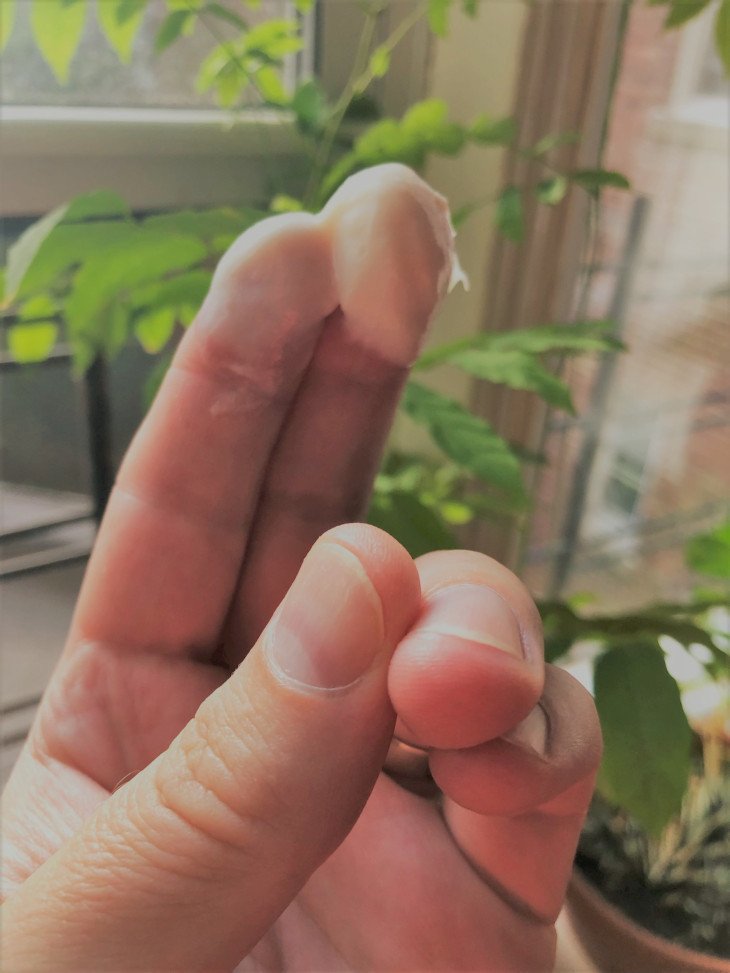
As you can see, it’s fluffy and loose and lovely.
So why use these butters? Because butters do a FANTASTIC job moisturizing the skin. Butters melt at room temperature, so they can be absorbed into your skin quickly, and once absorbed, they can act as a “refatting” agent, and keep your skin from losing moisture. That’s a wonderful thing, because having a beard can sap your skin of its hydration, and that’s one of the reasons guys end up with itchy, scratchy beards—they skin isn’t properly moisturized.
So that’s the main purpose of a butter: to hydrate your skin. There are only a few butters that can do that, and you’ll find that beard butters usually have either shea butter or cocoa butter or both, and only sometimes mango butter—that seems to be a lot less common.
You’ll notice in the paragraph above, we mentioned that butters do a great job moisturizing the skin, and we didn’t mention anything about beards. Weird, right? That’s because…
Even though guys use beard butter to enhance the look and health of their beards, the main function of a beard butter is to moisturize the skin under the beard.
Most of us forget about our skin when we grow a beard—we grow our facial hair out, and then forget that there’s skin under there. That’s not great, because forgetting about the skin under there means it can get really beat up and irritated. And that’s the beauty of a beard butter—because it’s so spreadable, and because it hydrates so well, it can be a great product to use to alleviate some of that scratchiness that comes with having a beard. Plus, many butters have additional skin-care ingredients, making them a great option if you’re experiencing skin irritation or itchiness. That’s a beard butter’s real purpose—to give your skin a little more support.
Alright, so now we have an answer to the “What is beard butter?” question, and we know what it does for your skin. It does have some great benefits for your beard, though, so what does a beard butter do for you beard?
It Can Hydrate Your Beard
Butters do a great job moisturizing your skin, but they’re also pretty great for the actual hair in your beard. They coat and hydrate the strands of your beard, and they can take a dry, prickly, hay-like beard and make it look a little more buoyant and healthy. That’s Job #2 of a beard balm—hydrating your actual facial hair.
Most beard butters contain a few other ingredients that help moisturize and soften hair, and they usually rely on oils to do so. There are plenty that you’ll see in various formulations, and they include jojoba oil, coconut oil, sunflower oil, argan oil, and almond oil. There are plenty of others, but those are the most common. Of those, jojoba oil is the real standout—its chemical structure is a lot like sebum, which is the oil your skin naturally produces, and it’s been known to even out hydration issues on the skin.
It Can Give Your Beard Some Body
It’s funny—a lot of guys don’t have any idea that beard butters can do great things for their skin and hair, and they just use it for its cosmetic properties. Because of all its ingredients—butters, oils, and other binding agents—beard butters can coat beard hairs and make them look a little denser. If you’ve got a portion of your beard that isn’t as thick as the rest, it may be able to give those “skimpier” areas a little more heft.
It’s not a sure thing—there are plenty of beards that might not perk up with a healthy portion of beard butter—but very often, it can make beards look a little dense and fuller.
It Can Make Your Beard Smell Really, Really Nice
This often gets overlooked, and truth be told, it’s our faaaaaaaaavorite thing about beard products: the scent. We know we’re supposed to talk about skin health and all that and try to get people to take care of themselves, but the truth is, we just love the way beard products smell. Even if they didn’t provide any skin or hair benefits, we’d still use them, just because we love so much how they smell.
Here’s the cool thing about beard butters: they’re often made in the “classic” scents that you’ll find with most beard products—that is, sandalwood, pine/fir, lime, etc.—but there are some really interesting, really quirky scents that you’ll also come across. Beard oils and beard balms are much more mainstream and widely used, and because of that, beard companies tend to stick to “tried-and-true” scents, but beard butters feature some really funky concoctions, like options like grapefruit, black pepper, and bergamot, or sea salt, or vanilla and tobacco… really fascinating combinations. We’ll talk more about that in our “Beard Butters We Like” section below.
Alright, now you now! Here’s the next question:
What Does a Beard Butter NOT Do for Your Beard?
From all the things we listed above, it sounds like beard butter is the bees-knees. And it is—but it doesn’t do everything. The one thing it doesn’t really do is sculpt your beard.
Beard butters do a lot to hydrate your beard, but they don’t really do much—or anything at all—to keep your beard in place. They’ll give it a little body and make it look fuller, but if you’ve got a big, bushy beard, and you find that it likes to jut out this way and that, a beard butter isn’t likely to tame it for you. If your beard tends to drop, twist, turn, etc.—beard butter probably won’t fix that.
The reason for that is because it doesn’t really contain any ingredients that are known to tamp a beard down. The main ingredient used to tamp a beard down is wax (and if you find a beard butter that does have wax in it, it’s usually a *very* small amount). Wax—usually beeswax, but sometimes carnauba wax—is the main ingredient that beard balms and beard waxes feature to give you some “sculpting ability.”
That actually leads us to the next question we get a lot:
What’s the Difference Between Beard Butter and Other Products?
We’ve written about this elsewhere, so here’s a very quick breakdown:
Beard Oils. Beard oils are just that—oils—and they’re used to hydrate beard hair. They do a great job hydrating your beard hair… and that’s it. They provide some support for your skin, but they can be hard to actually get on your skin, because your beard soaks it up. The consistency of a butter actually helps it cleave to your skin.
Beard Balms. Beard balms are perhaps closest to beard butters—they contain oils and some butters and some waxes—but they’re a little denser, and they’re not as easy to get on to your skin. They do provide a little bit of “hold” and you can use them for styling purposes, and while they do offer some skincare qualities, they’re not as “skincare-focused” as butters are.
Beard Wax. Beard wax is mostly wax, and doesn’t really have any moisturizing or skincare properties—it’s used solely to style and sculpt a beard. It’s really dense—you often have to heat it to get it out of the tin, or chip it out—and it’s really hard to get out of your beard, because it’s an actual wax, and it adheres and dries on your beard hair.
So, basically, here’s how it plays out: oils are for hydrating your beard but don’t provide any hold; beard balms are for hydrating your beard and providing hold; beard waxes are for sculpting your beard but don’t provide any skin/beard moisturizing at all, and beard butters are for hydrating your beard hair but MOSTLY your skin—and that’s why they’re really popular with guys who have itchy and/or irritated skin underneath their beards.
If you’d like to read more, we talk here about beard butter vs. beard balm, and we talk here about beard butter vs. beard oil.
Beard Butters That May Be Worth Looking Into
Usually when people are asking “What is beard butter?,” they want to know of some products they can use. We do a full run-down of all of our favorite beard butters here, but here’s a very quick recap of our favorites, along with what we like about them:
The “Classic”: Maestro’s Beard Butter
This is, perhaps, the best-known beard butter: Maestro’s Beard Butter (affiliate link). In addition to actual butter—it’s got both shea butter and cocoa butter—it’s got a range of skincare ingredients, including coconut oil, wheat germ oil, and mulberry bark extract, and that’s wonderful. Like most beard butters, its first function is skin care.
That said, our favorite thing about Meastro’s is its totally unique scent profile: it’s a mix of grapefruit (citrus-y, sweet), black pepper (perky, alertful), and bergamot (also a citrus, someplace between a lemon and a lime). The combination of all of these is a deep, rich scent that’s… very dignified, somehow. It’s serious and weighty like a cologne, but without that sort of “clubby” smell that a cologne has. We use this when we’re going to formal events—suits and tuxes sorts of things. A really unique and really interesting blend.
The “All-Natural”: Every Man Jack Beard Butter
A lot of beard butters have great ingredients, but many also include some synthetic ones, as well. That’s actually an issue for a lot of butters—they’re not as likely to have “all-natural” formulations, the way that beard oils and beard balms do. There’s a reason for that—because beard butter’s focus is on skincare, makers of beard butters use a lot of synthetic skincare ingredients that get the job done… but aren’t so natural.
And that’s why we like Every Man Jack Beard Butter (affiliate link): they seem to make an effort to dis-include as many synthetic ingredients as possible. Of all the beard butter recipes we’ve seen, they seem to have the fewest “chemical-y” sounding ingredients, and their formulations are free of parabens, chemicals, and dyes. It’s not totally natural—there are still ingredients you wouldn’t find in all-natural beard oils/beard balms—but as far as beard butters go, it’s one of the “cleaner” ones we’ve found.
One other thing, too—this has a fascinating scent: sea salt. Kind of reminiscent of the ocean, but without all the dead fish. Nice.
The “Non-Butter Butter”: Bluebeards Original Beard Saver
This isn’t technically a beard butter, but we try to mention it as often as we can, because guys who are looking for some relief from itchiness/skin irritation often have good luck with it:
Bluebeards Original Beard Saver (affiliate link). It doesn’t seem to advertise itself as a butter—even though it has shea butter in the ingredient list!—but it has all the hallmarks of a good beard butter, and it’s designed specifically to fight beard itch.
Your mileage may vary, of course, but we’ve had a lot of luck with this one.
Bigger Better Butter
There you have it! Any questions? Check out our “Beard Butters” category for more info. There’s a lot there.
In the meantime, all the best to you! Be good, have fun, and handsome beard!
Michael Morris is the head writer here at Rough and Tumble Gentleman. He's got a ducktail beard and loves Brazilian jiu-jitsu. He's married to the woman of his dreams and lives in Brooklyn, NY.

